- Home
- Benefits of flower strips in arable fields
Benefits of flower strips in arable fields

Benefits of flower strips in arable fields
Can you reduce your use of insecticides with in-field flower strips? A trial at our Strategic Cereal Farm West is testing the impact of non-crop habitats on biodiversity.
Benefits of flower strips - trial summary
- Start: 29 September 2020
- End: Harvest 2021
Objective
To find out whether flower strips affect the diversity, distribution and number of beneficials and pests in an arable field.
Why are flower strips beneficial to arable farms?
Integrated pest management is an important part of arable farming. Our previous research reported that non-crop habitats are important sources of biodiversity. This trial is looking at whether the results found in research trials are also seen on a commercial farm.
Flower strips attract insects that are beneficial for pollination and pest control. Field margins play an important role in enhancing insect predators and parasitoids. The trial will see if flower strips can help farmers to reduce their use of insecticides.
How is the flower strip trial run?
This field-scale trial uses three fields on the farm:
- Field 42:
- 32-hectare field in the farm standard.
- Clay soil and no flower strips
- Field 40:
- 9-hectare field with flower strips at the edge.
- Medium to very heavy soil
- Field 43
- 5-hectare field with flower strips within the field and at the field edge
- Medium soil
For harvest 2021, the fields are in RGT Saki winter wheat. Strategic Cereal Farm host, Rob Fox, drilled the trial on 29 September 2020 at a rate of 192 kg/ha.
The seed mix contains:
- Achillea millefolium Yarrow
- Anthriscus sylvestris Cow parsley
- Centaurea nigra Common knapweed
- Chaerophyllum temulum Rough chervil
- Daucus carota Wild carrot
- Echium vulgare Viper's bugloss
- Geranium pratense Meadow cranesbil
- Knautia arvensis Field scabious
- Lathyrus pratensis Meadow vetchling
- Leontodon hispidus Rough hawkbit
- Leucanthemum vulgare Oxeye daisy
- Lotus corniculatus Birdsfoot trefoil
- Pastinaca sativa Wild parsnip
- Prunella vulgaris Selfheal
- Pulicaria dysenterica Common fleabane
- Silene dioica Red campion
- Stachys sylvatica Hedge woundwort
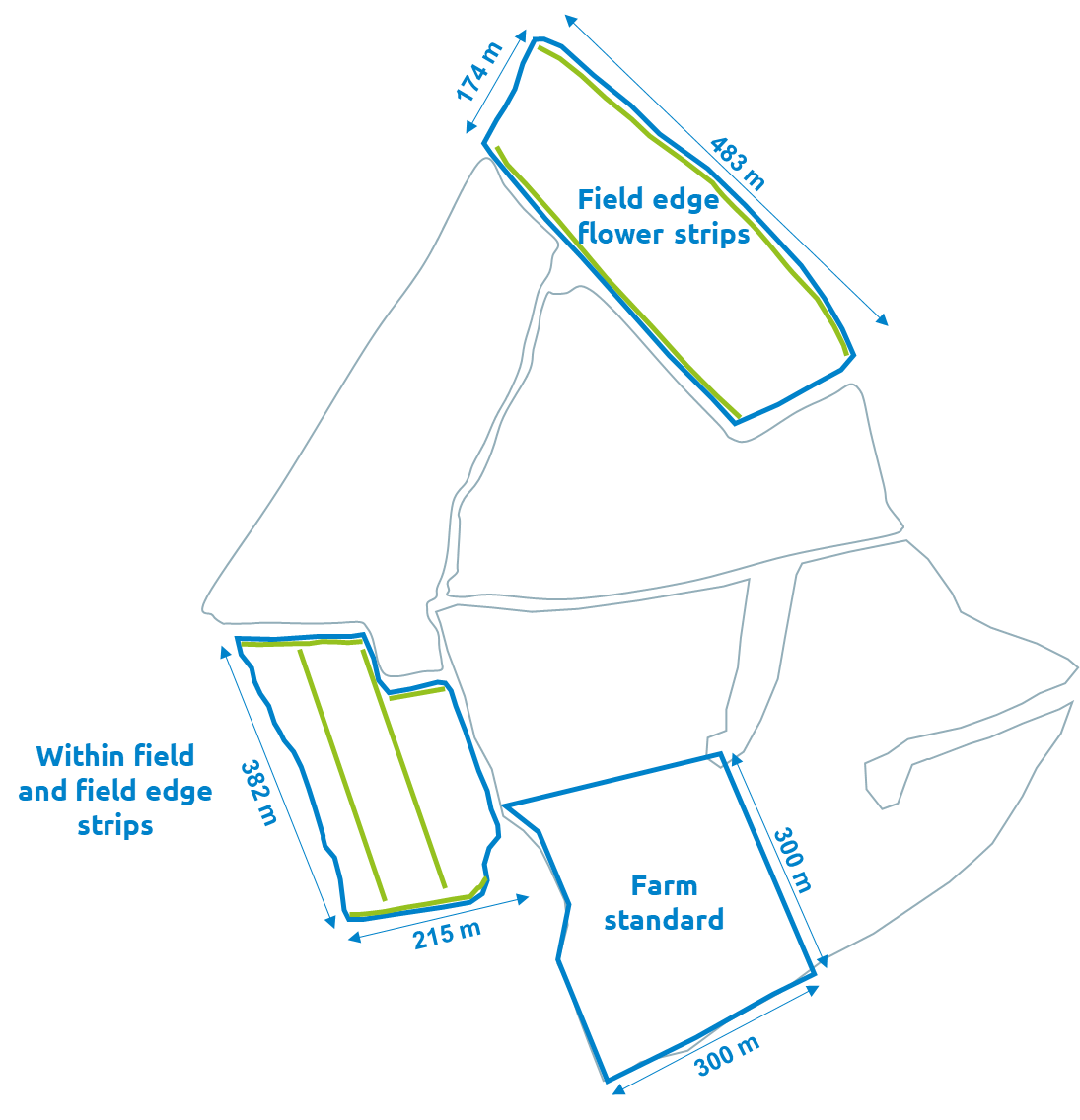
Assessing the benefits of flower strips
The diversity of pests and their natural enemies changes through the seasons, as different species breed during differ times of year and specialise on different food sources.
The boxes below summarise key functional groups of pests and thier natural enemies. In the tables, the row number indicates the average number recorded of that group per trap during the respective trapping periods, the colour indicates whether this is relatively low (red), average (amber) or high (green) relative to the other fields sampled in this study, or vice versa for pests where low is green and red is high abundance.
Slugs
- Slug abundance in the fields was below treatment threshold
- Slug abundance was much higher in floral margins and internal strips

Ground beetles - Group 1 (8-18mm)
- More internal parts of fields
- More in floral habitats in fields 40 and 43 than in the grass margin in Field 42
- Group 1 carabid abundance was highest within floral strips and further into the cropped area
- Abundance was lowest in the simple grass margin

Ground beetles - Group 6 (3-10mm)
- Where present, the distribution of group 6 beetles was even within the field
- Fewest were found in Field 42, where there were no floral margins/internal strips
- Group 6 carabid abundance was highest in fields with floral margins/internal strips
- None were found in the simple grass margin

Aphids (including both pests and non-pest species)
- Aphid abundance was highest in floral margins – however this is due to greater diversity of species including both pest and non-pest species. These margins therefore act as a source of alternative prey for beneficial natural enemies.
- Aphid abundance in the crop was low. Here the majority of aphids were grain aphids, but abundance was well below the threshold for treatment
- Too few aphids were collected during visual assessments on which to draw conclusions
- Aphid abundance was highest within floral margins/strips and the grass margin

Aphid predators and parasitoid wasps
Overall, the relative abundance of aphid predators and parasitoid wasps was highest in the cropped areas, reflecting the ability of these natural enemies to locate their primary prey in the crop. Both the predators and parasitoid wasps were easily able to move up to at least 100m into the crop, without notable impact on abundance.
All the natural enemies of aphid pests were found in this study were present in the floral margins. Hoverfly larvae and soldier beetles were found in highest abundance in the intern floral strips.
Hoverfly larvae
- These were the most abundance aphid predators collected
- Mostly found in the crops, but also abundance in the internal floral strips

Soldier beetles
- These generalist predators feed on both aphids and other pests, as well as floral resource
- Mostly found in Field 43, but in all fields
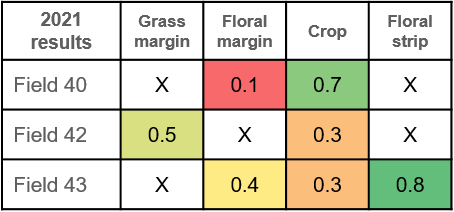
Money spiders
- Generalist predators web builders were found in all fields, and highest numbers were in the crop
- Relatively high numbers were also found in floral habitats
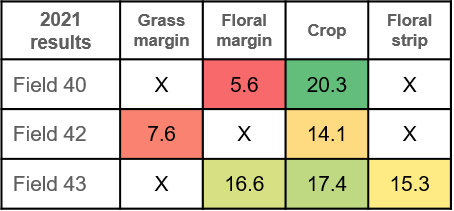
Parasitoid wasps
- Adults are fairly mobile, but tend to closely follow their aphid prey, and so were mainly found in the crop
- They do benefit from floral resources
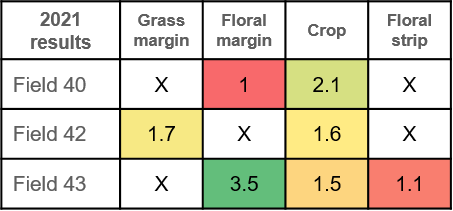
Aphid predation
The proportion of aphids remaining on bait cards after 24 hours indicates predation activities in the local area.
- Relative differences between locations does not necessarily indicate better or worse levels of biological control; high rates may result from highly active individual predators with few prey available, or from high numbers of predators visiting hot spots of aphid abundance
- Aphids were predated on the cards in all areas of all of the fields monitored
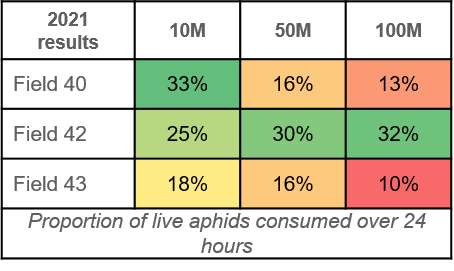
How have the strips established?
A wide range of species, both sown and non-sown were recorded in July 2021. In June 2020 common knapweed, rough chervil, meadow vetchling, rough hawkbit and common fleabane were sown but not recorded. By July 2021 Common knapweed had emerged, suggesting a delayed germination for this species.
Have the strips affected the crop?
The yield across Field 43 was highly variable, demonstrating the impact on in field variation on crop performance cause by field specific factors. The role of internal strips is not primarily to improve performance in the immediate vicinity; however it is important that they do not negatively impact the crop. There was no evidence in this trial that the crop performance was impacted 30m either side of the floral strips. This shows that internal floral strips can be installed without causing knock-on losses on the rest of the crop.
Our Strategic Farms are an opportunity to see how to use our research on a commercial farm. Find out more about our Strategic Cereal Farm West Programme
Useful resources
Using flower mixes to support conservation efforts and improve crop management

